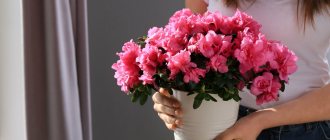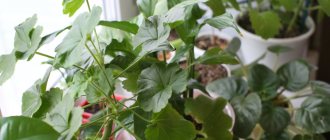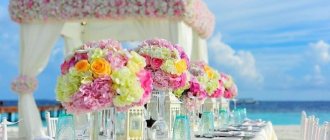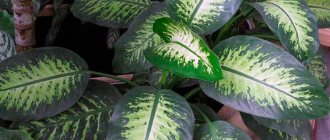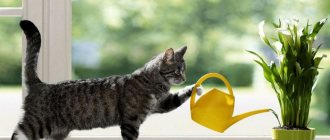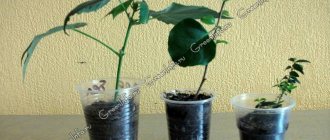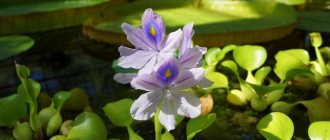Every apartment or house will look empty and uncomfortable if there are no indoor plants. Indoor plants enliven any room and create a unique microclimate.
You can add an elegant touch to the interior design of an apartment or house by using not only individual plants, but also compositions of indoor flowers. Designers and florists can combine small and large plants, smooth and prickly, flowering and non-blooming, bright and muted in shades.
The most important rule in this case will be that the plants can grow next to each other, and they will not have to be transplanted to other places.
Obviously, the rules for caring for plants in a composition with common soil should be the same. In the case of a combination of plants in their own pots, the space between them is filled with decorative material (sisal, colored pebbles, pebbles). Florists often use the latter option as a gift, combining potted plants in a large wicker basket.
Indoor plants in the interior of an apartment, correctly assembled into a single composition, represent a living decor that looks harmonious against the background of other things.
In order to create compositions from indoor plants, you need to understand what types of compositions there are and know the rules for their composition. Having learned this information, not only a florist, but also any gardener will be able to create beautiful mini-gardens from indoor flowers.
Types of compositions from indoor plants
Depending on the interior of the apartment, the florist chooses what type of composition will organically fit into the surrounding environment. The following types of compositions are distinguished:
1. Mini-garden of indoor flowers in one container.
Plants can accommodate:
- in the basket;
- in large or long pots;
- in a flowerpot;
- in containers of unusual shape (for example, figurines with a recess, wooden driftwood);
2. Vertical floral panels.
Subtypes of panels are:
- a flower picture is a light structure, inside of which there is earth; plants are planted in special holes. Watering is carried out from above the container.
- a living wall is a vertical garden, the design of which is more complex and can be divided into several compartments. Plants in a vertical garden require daily care and special drip watering;
3. Florariums are a group of plants planted in glass containers of various shapes. We talked about florariums in detail in this article.
4. Horizontal pot group - a group of flowers in pots located on one stand or pallet;
5. Vertical pot group - a group of flowers in pots arranged vertically or in a cascade.
Advantages of a container garden
Why loosen the soil around plants, when growing plants in indoor pots, after rain (watering). tips for 2022
Growing flowers in pots has gained popularity due to the following factors:
- Space saving. Flower beds in containers are placed on verandas, on stairs, on vertical stands, on areas of the foundation near the house or gazebo, on the edges of benches. Pots can be placed at different levels so that even short plants can be clearly visible.
- Mobility. Flower pots can easily be hidden if difficult weather conditions are expected: hail, late frosts, etc. They can also be removed before treating the garden with hazardous chemicals. Finally, rearrangement can be used simply to change the composition.
- Safety. Flowers growing in flowerpots are not damaged by mole crickets, chafer larvae and similar insects living in the soil. If one plant becomes sick, it can be immediately quarantined.
- Individual conditions for each flower. You can grow plants in pots for which the soil on the site is not suitable. In addition, you can create compositions of flowers that do not get along well side by side in open ground due to different requirements for acidity, frequency of watering, etc.
This is interesting:
A container flower garden is an excellent way to hide the error of landscape design, for example, to disguise an unsightly object on the site. Such a “flower bed” will always remain elegant: if the plant has already faded, it can be immediately sent to rest, replacing it with another flowerpot.
Vertical pot group
If space in the apartment is limited, but the gardener’s desire to have a beautiful garden at home is enormous, then vertical pot groups help with this.
Vertical compositions are placed on different surfaces:
- wooden or metal stands;
- metal picket fence on the wall;
- hanging flowerpots or baskets;
- shelving (for example, corner);
- walls with a special recess for pots.
For vertical compositions, various indoor plants are used, but most often ampelous ones. The name "ampel" plants (from the German Ampel) was given for their hanging and creeping shape. Bellflower, nidularium, ivy, ficus creeping, fittonia, hoya and other ampelous flowers can be seen in potted groups.
The vertical arrangement not only visually increases the volume of the room, but also improves the microclimate in the house, which is why these compositions are used in large houses by designers.
The most important thing for both flower growers and professional craftsmen is to follow certain rules for creating compositions.
Chlorophytum and syngonium
Chlorophytum is a herbaceous plant with long and narrow leaves. The flower is unpretentious and does not require special maintenance conditions. With simple care, gardeners will grow a lush, beautiful bush.
Syngonium is a tropical plant with large leaves on a long stalk. The flower does not need special care; even a novice gardener can handle it. Good lighting and moderate watering will be enough.
Syngonium and chlorophytum are decorative deciduous plants that combine with each other. They have similar requirements for temperature, lighting and watering. The soil is suitable loose and breathable. This way there will be no stagnation of moisture and rotting of the roots. Both plants are large, so it is worth planting them at a distance from each other. For these purposes, it is better to use not a round pot, but a rectangular and elongated one. This way there will be no extra shadow, the roots will have enough nutrition and microelements.
Rules for composing flower arrangements
To create compositions of indoor plants, you need to know how to plant plants so that they grow in the same pot or are located nearby in a pot group.
There are a number of rules for planting plants in a composition:
- Low plants are placed in the foreground, tall plants in the background;
- Tall plants can be the center of the composition, surrounded by small plants;
- Plants that grow well next to each other are selected;
- Each plant should have its own space, that is, planting should not be too dense, and the growth rate of each plant should be taken into account.
- It is important to create a sense of volume in the composition.
It is easiest to apply these rules when creating compositions from plants of the same type, such as cacti and succulents. It is more difficult to do this with different types of plants, but in this case they look at the following characteristics:
- moisture-loving plant;
- need for sunlight;
- temperature regime;
- growth rate;
- ventilation of the room.
Growing together in one container, properly selected plants create a microclimate that makes caring for them easy. What plants are used to create flower arrangements and what combination of them does not create difficulties in care?
Placement of a mini-kindergarten and subsequent care
It is better to place the composition in the largest room in the house. As for the garden plot, it is more correct to place the mini-garden in the main place - often it is located on the main road on the way to the house. If there are several potted gardens, they can be placed right around the perimeter, or placed in a row so that each is clearly visible from the main road. It is also important to consider which plants will grow – light- or shade-loving.
A garden requires more attention to care than a regular potted plant. If mostly unpretentious plants are planted (cacti, succulents), then there are no special recommendations for care. If there are more demanding ones (decorative roses), then you need to carefully monitor the watering regime. When they fade, you need to remove fallen petals, dig up wilted plants and make sure that neighboring bushes do not interfere with each other. Perhaps some of them would be better planted.
Specific recommendations for maintaining a miniature garden can be determined based on the type of plants that live in it.
Plants for flower arrangements and their combinations
To create compositions in a pot, various plants are used, among which cacti and succulents are very popular. Read about the varieties of home succulents and the rules for caring for them in the article “Indoor succulent plants.” They are sun-loving and easy to care for; they do not need to be replanted quickly. Other plants are more demanding to care for and need to be transplanted into other pots or containers as they grow.
Of course, to create indoor compositions, you don’t need to limit yourself only to succulent plants. Below are indoor flowers with photos of plants suitable for decorating compositions, and features for caring for them.
Anthurium
Decembrist
Crassula
Orchid
Anthurium needs moderate watering 2-3 times a week, indirect sunlight, air temperature 18-23 degrees.
Decembrist should be watered 1-2 times a week. It is optimal for the plant to be in partial shade at an air temperature of 18 to 30 degrees. Crassula or money tree is a sun-loving plant, but direct sunlight should be avoided. In summer, the optimal temperature for the plant is 20-25 degrees, in winter 10-16. You should water the money tree no more than 2 times a week.
Orchids need bright light and a temperature of 20 to 25 degrees. You can water only with warm water from the bottom of the plant and no more than once a week. Orchids need to be moisturized, especially in winter. Dendrobium nobele and phalaenopsis are most often planted in compositions.
Hoya
Spathiphyllum
Violet
Scheffler
Climbing Hoya is divided into two subspecies. Some Hoya plants love sunbathing, while others should avoid direct sunlight. Excessive watering is harmful for hoya; the plant is watered as the soil becomes dry, but at the same time the flower is moistened. As for the temperature, the optimal temperature will be 17-25 degrees.
Caring for spathiphyllum at home is not difficult. The plant likes abundant watering 2-3 times a week, room temperature 22-23 degrees and light partial shade. The most important thing for spathiphyllum is to avoid drafts and overflow of soil.
Violet is light-loving, but direct rays should be avoided. The flower does not need excessive watering more than 2 times a week, but loves moisture. The optimal temperature is 20-25 degrees.
Schefflera loves spraying and grows well in both sunny and partial shade. The plant requires moderate watering 1-2 times a week and an air temperature of 15-23 degrees. But still, you should not expose the shefflera to direct sunlight.
The following examples of compositions from these colors look interesting in combination:
- Anthurium + fittonia + hedera;
- Crassula (money tree) + cacti + succulents;
- Spathiphyllum + phytonia + chamedorea + hedera;
- Hanging gardens of several types of hoya in flower pots;
- Violet + orchid (for example, dendrobium nobele) + fittonia;
- Schefflera + ivy.
The creation of a flower arrangement depends on the imagination of the author, and its complexity depends on the level of professionalism. Professional florists can create floral works of art even in a small apartment. Not only flower masters, but also novice flower growers are able to create a beautiful and amazing mini-garden with their own hands.
Comply with agricultural technology requirements
Bulbous plants, as a rule, do not require complex agricultural technology, but some species must be dug up annually (for example, tulips). This should not be neglected - without digging, the bulbs of such plants become smaller and deeply buried, which inevitably affects the quality of flowering. When choosing a place for planting, be sure to take this nuance into account: it should be convenient for you to dig up the bulbs, and crops growing nearby should not suffer from such work.
Remember also that some plants can be quite aggressive. Most often, spring-flowering small-bulb species - scillas, muscari and others - actively grow. This feature is good to use in free plantings - in natural style compositions. Randomly plant these flowers in your garden and let them go wild to create a natural landscape.
Do not use these crops where it is important for you to maintain strict lines and proportions - this will only be possible in the year of planting
If you use fast-growing species, for example, to create flower borders, take care of the restrictions: a wide border tape buried around the perimeter of the plantings, nets or containers with small cells will help keep the bulbs within their designated boundaries. But keep in mind that such cramped conditions will require frequent (every 2-3 years) digging of bulbs to separate overgrown nests; Small bulbous plants do not need this in free plantings.
Making potted arrangements with your own hands
As we have already said, flower arrangements made from cacti and succulents are the most popular among beginning gardeners. Such compositions are not difficult to create.
To create the simplest mini-gardens, we will use step-by-step instructions:
- Let's prepare the necessary materials and tools - expanded clay, special soil, decorative elements and stones, a long pot, a small spatula, a watering can.
- Place drainage at the bottom of the pot and add soil;
- Let's take several types of cacti and succulents and plant them in the ground in accordance with the rules for composing compositions;
- We will water the plants;
- We will decorate the surface between the plants with decorative elements and stones.
All of the above steps are demonstrated in detail in the video master class. Watch and be inspired!
Mini-garden in a pot: distinctive features and options for use in garden and home decor
Before you start creating such a garden, you need to be inspired by some initial idea. Perhaps the garden will be arranged in tiers and lined with beautiful pebbles. Perhaps, in addition to plants, the decoration will include interior items (a model of a house or a castle). Or decor using multi-colored stones will highlight small trees. Here you need to use your wildest imaginations - even broken pots will be an excellent tool for developing a design.
A mini-garden differs from ordinary window flowers and from a garden plot. The following features can be highlighted:
- Compared to the plants on the window, the garden must have its own flower and plant composition, based on a specific plot, as well as improvised means, decorative figures, and special materials;
- the garden also looks much more varied and interesting than single-standing plants; it can be transformed, change the scenery and even replant individual plants;
- Compared to a regular garden plot, a mini-garden is mobile and can be at home all year round and please the eye.
